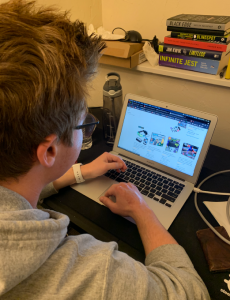A combination of Covid-19, ease of online shopping, and crowds to blame.
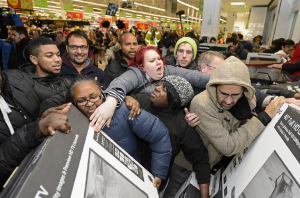
The photo was taken during Black Friday 2016 of shoppers struggling to purchase televisions at a supermarket.
We all remember the famous photos and videos of stampedes of Black Friday shoppers. Yet it seems that each year more shoppers choose to spend their money on internet purchases as online sales out-gun in-store retailers in sales. Since the start of the pandemic, in-store shopping has declined dramatically – though 2021 has seen a 47.5% increase in foot traffic in brick and mortar stores since 2020, CNBC said.
In 2019 prior to the pandemic, Businesswire said, brick and mortar stores had 28.3% more shoppers than this black Friday, Nov. 26, according to data from Sensoramic Solutions. Online sales have not seen a decline as their brick and mortar cousins. According to the Adobe Digital Economy Index, consumers spent $8.9 billion on online shopping on Black Friday alone. Online sales are expected to be even higher on Cyber Monday, Nov. 29.
So the question remains – why are more people choosing to shop online rather than in-store? One Black Friday shopper, Jameson Saddler, a Bradley University undergrad, chose to shop on Amazon instead of an in-person store because he wished to avoid the crowds.
“It’s not so much for the fear of it (Covid), but who wants to leave their house and stand in a line for who knows how long,” Jameson said. “I think it’s just too easy to shop online and I know it’s discouraging to real stores but even the sales online are better.”
Jameson went on to cite that it is even more difficult for him to shop in person because of his lack of transportation. Because the roads can get so busy, it is harder for services such as Lyft or Uber to keep up with consumer demands on Black Friday.
Black Friday may be a shopper’s dream, but for those who work in the retail business, it can be a nightmare. Paige Donnelly, a high school senior, worked at Old Navy during Black Friday this year. “Well, it felt like the longest shift ever. It felt overwhelming and it was difficult keeping up with all of the customers that were coming in and out throughout the day,” Paige stated.
It was Paige’s first-ever Black Friday in retail, and she found it to be difficult to deal with the hundreds of customers bogging down the store. “The line was definitely never-ending and it was hard to believe that many people were in the store,” she said while commenting on cashiering during the big rush.
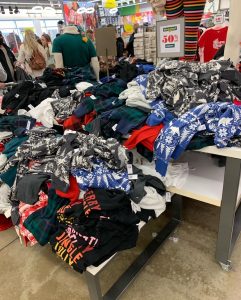
Photo of Peoria Old Navy’s merchandise after a crowd of customers searched through it ruining the neatly folded stacks. (Nov. 26, 2021)
The general manager of Peoria’s Old Navy, 5201 W War Memorial Drive, Dawn Draminski has over five years of experience at her Old Navy Store. When asked about 2021’s Black Friday in comparison to previous years she had this to say:
“Well it was different – previous years we’ve been open on Thanksgiving as well. But this year was way busier than last . . . We didn’t do doorbusters this year like we have in the past, but we saw tons of traffic and sales this year.”
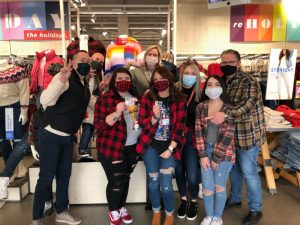
Old Navy, 5201 W. War Memorial Drive, Peoria IL 61615, Black Friday morning crew. Paige Donnelly pictured second from right. General manager, Dawn Draminski, not pictured. (Nov. 26, 2021).
Dawn did not, however, think that Covid-19 was really to blame for the lack of in-store customers. “No. Last year – yes. This year maybe some but not really. Half the people who came in weren’t even wearing a mask so I doubt Covid really had much of an impact on it,” she responded.
In-store personnel are not the only ones affected by the swarm of consumers on Black Friday. Casey Johnson works for a delivery company in Temecula, CA. that is contracted by Amazon and shared just how much stress Amazon puts on its employees.

An exhausted Casey Johnson after his 2020 Cyber Monday shift that lasted over nine hours, delivering over 300 packages without even a bathroom break. (Temecula, CA. Nov. 30, 2020).
“If you return packages back to the warehouse, the company gets penalized and can result in fewer routes designated to the company, resulting in less money for the company. Because of this, company owners put a lot of pressure on the delivery drivers to deliver every package as fast as possible or it can cost you your job,”
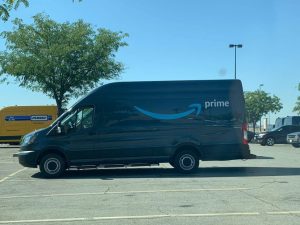
Casey’s company van in which he used during his delivery shifts. The van can be seen weighed down by over 300 packages residing in the back. (Temecula, CA. Nov. 30)
Casey went on to say, “When you’re under that much stress you are sometimes willing to put up with not taking breaks, not eating lunch, working all hours into the night, and in a lot of cases you don’t stop to use the restroom. Black Friday/Cyber Monday was the worst time of year for delivery drivers,”
